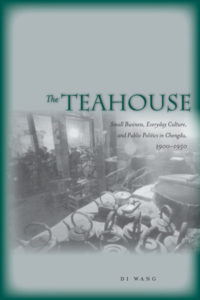 This book deals with a very specific topic, that of teahouse culture in Chengdu, Sichuan from the 1900s to 1950, so it’s unlikely to appeal to a broader tea enthusiast. But that’s never stopped me. This book touches on culture, politics, women’s rights, class relations, and the public perception of teahouse workers and teahouse goers. It’s dense with information, but very easy to read.
This book deals with a very specific topic, that of teahouse culture in Chengdu, Sichuan from the 1900s to 1950, so it’s unlikely to appeal to a broader tea enthusiast. But that’s never stopped me. This book touches on culture, politics, women’s rights, class relations, and the public perception of teahouse workers and teahouse goers. It’s dense with information, but very easy to read.
There’s a sequel dealing with Chengdu from the dawn of the People’s Republic to present day, and you can bet I’ll by laying hands on that in the future. There’s a couple other books I plan to read in the meantime, though.
Chengdu is described as having the highest density of tea houses in Sichuan, if not China as a whole. It has a unique teahouse culture, frequently mentioned in historic accounts and novels, and is a perfect vessel to explore small businesses, as well as social and public life; the teahouse served much the same purpose as the western saloon, bringing together local news, gossip, gambling, women of the night, and business. They served as central hubs for peddlers, merchants, venues for small businesses (pedicurists, barbers), club houses for secret societies, guilds, and unions, and a source of entertainment in theatres, operas, and lecturers. They were frequented by all classes, from the leisure class to elites, and often celebrated and condemned for it.
The book is divided into three sections, each exploring a facet of the teahouse. Part one describes teahouse proprietors, workers and employees, as well as their relationship with the government and regulations. Chapters detail the spread of teahouses in Chengdu, the creation of the Tea House Guild in 1931 and its predecessor, the Union of Chengdu Teahouse Workers created in 1939, and the unique services offered by the teahouse itself (tea, boiled water, hot towels, and herb mixing, among other things). In contrast to those who found work inside teahouses but were not directly employed by them, which are detailed in a later section. The part also covers the different employees of the teahouse—including women’s short stint as waitresses before they were outlawed, and the harassment they faced.
Part two details the teahouse regulars. This part is particularly dense, as it covers not only those who went for leisure, the different classes and how they were viewed, but also those frequenting the teahouse to conduct business, or often to work in the teahouse proper as contractors and performers. This covered barbers and pedicurists who did their work in the teahouse while their clients sipped tea, as well as performers who took to the teahouse’s stage for theatre, opera, or lectures. The teahouse was also frequented by freelance men selling their wares, or offering services, as well as those looking for, or offering work. And was frequented by prostitutes, one of the few instances where working women could be seen in public, before waitresses were allowed work in teahouses.
The final section deals with politics, tying into the first section and the relationship between teahouses and the government. How the government tried to enforce regulations, and how each era of the 1900s effected teahouse structure (Qing, Republic, Warlord Era, and the beginning of the People’s Republic). In general, it explored how the teahouse was the central hub of political discussion and news, often making it a dangerous enemy of the government and censorship.
The book uses fairly plain, easy to follow language; it’s not particularly flowery–it’s not intended for that audience–and as a result, I found it really easy to pick up and read. I’d almost say it was difficult to put down; I found it very engaging. It wasn’t a slog, and it helps that it’s under 300 pages. A basic understanding of Chinese history from Qing to the People’s Republic is useful, as the book doesn’t handhold you through context and events. I have taken a class, but I’m a bit rusty and did find myself having to check a few dates and look up a few details.
It was extremely interesting to see the parallels drawn with western saloons and coffee houses in terms of the important social hub teahouses played in communities. Though they bridged social divides, they were viewed as low class/often corrupting and lecherous establishments, the way bars often are. It was an extremely interesting book, and gave me a list of tangents to research later. Though this is a library checkout, I think I’ll be looking to add it to my permanent tea bookcase in the future.
While looking for a photo of the cover of this book to add, I realized CULtea reviewed this all the way back on 2014, before the sequel was published.
This is a fairly affordable book to find. Unfortunately, there’s no ebook available, but used and new the softcover seems to go for $35-40CAD regularly.
- Amazon – $40CAD
- Abebooks – $35CAD




Leave a Reply
You must be logged in to post a comment.